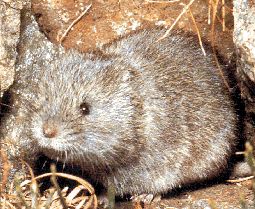
The European water vole or northern water vole, is a semi-aquatic rodent. It is often informally called the water rat, though it only superficially resembles a true rat. Water voles have rounder noses than rats, deep brown fur, chubby faces and short fuzzy ears; unlike rats their tails, paws and ears are covered with hair.

The Arvicolinae are a subfamily of rodents that includes the voles, lemmings, and muskrats. They are most closely related to the other subfamilies in the Cricetidae. Some authorities place the subfamily Arvicolinae in the family Muridae along with all other members of the superfamily Muroidea. Some refer to the subfamily as the Microtinae or rank the taxon as a full family, the Arvicolidae.

The long-tailed vole, in some areas known as the San Bernardino long-tailed vole, is a small vole found in western North America. They have short ears and a long tail. Their fur is gray brown with light gray underparts. They are around 18 cm (7.1 in) long with an 8 cm (3.1 in) tail and weigh about 50 g (1.8 oz).

The water voles are large voles in the genus Arvicola. They are found in both aquatic and dry habitat through Europe and much of northern Asia. A water vole found in Western North America was historically considered a member of this genus, but has been shown to be more closely related to members of the genus Microtus. Head and body lengths are 12–22 cm, tail lengths are 6.5–12.5 cm, and their weights are 70–250 g. The animals may exhibit indeterminate growth. They are thick-furred and have hairy fringes on their feet that improve their swimming ability.

The southwestern water vole or southern water vole is a large amphibious vole native to most of France and southwestwards through Spain and Portugal. It is listed on the IUCN Red List as vulnerable. Although historically considered to be a member of the same species as the European water vole, Musser and Carleton (2005) considered it distinct enough to warrant full species status. It is threatened for many of the same reasons as the European water vole, and a campaign is currently underway to seek protection for the species, both at a national level and at European Union level.

The European snow vole or snow vole is a species of rodent in the family Cricetidae. It has dense, pale grey fur and a pale-coloured tail and can reach about 14 cm (5.5 in) long, with a tail which is 7 cm (2.8 in) long.
Maximowicz's vole is a species of rodent in the family Cricetidae. It is found in northeastern China, Mongolia, and eastern Russia.

The creeping vole, sometimes known as the Oregon meadow mouse, is a small rodent in the family Cricetidae. Ranging across the Pacific Northwest of North America, it is found in forests, grasslands, woodlands, and chaparral environments. The small-tailed, furry, brownish-gray mammal was first described in the scientific literature in 1839, from a specimen collected near the mouth of the Columbia River. The smallest vole in its range, it weighs around 19 g. At birth, they weigh 1.6 g, are naked, pink, unable to open their eyes, and the ear flaps completely cover the ear openings. Although not always common throughout their range, there are no major concerns for their survival as a species.

Arvicolini is a tribe of voles in the subfamily Arvicolinae.

Igor Zagorodniuk is a Ukrainian zoologist, mammalogist, ecologist, and founder of Theriological school. He is a laureate of the State Prize of Ukraine in the field of science and technology (2015), and the author of more than 500 scientific publications.









